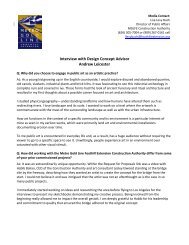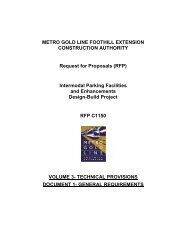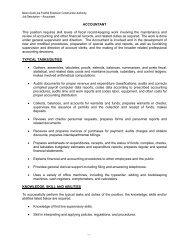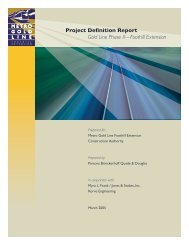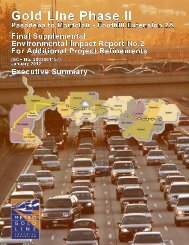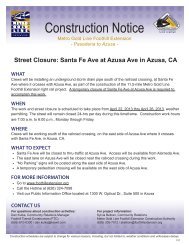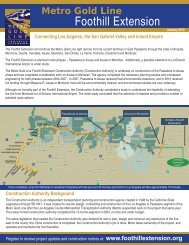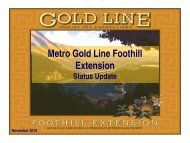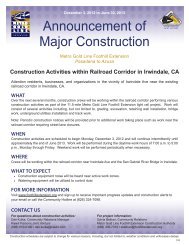Part 3 - Metro Gold Line Foothill Extension
Part 3 - Metro Gold Line Foothill Extension
Part 3 - Metro Gold Line Foothill Extension
You also want an ePaper? Increase the reach of your titles
YUMPU automatically turns print PDFs into web optimized ePapers that Google loves.
Noise and Vibration Technical Report: <strong>Metro</strong> <strong>Gold</strong> <strong>Line</strong> <strong>Foothill</strong> <strong>Extension</strong>, Azusa to Montclair<br />
July 2012<br />
Page 92<br />
square (RMS) vibration velocity. RMS is defined as the average of the squared amplitude of the vibration<br />
signal. To avoid confusion with sound decibels, the abbreviation VdB is used for vibration decibels. All<br />
vibration decibels in this report use a decibel reference of 1 micro-inch/second (µin/sec.). 6 The potential<br />
adverse effects of rail transit groundborne vibration are as follows:<br />
• Perceptible Building Vibration: This is when building occupants feel the vibration of the floor<br />
or other building surfaces. Experience has shown that the threshold of human perception is<br />
around 65 VdB and that vibration that exceeds 75 to 80 VdB may be intrusive and annoying to<br />
building occupants.<br />
• Rattle: The building vibration can cause rattling of items on shelves and hanging on walls, and<br />
various different rattle and buzzing noises from windows and doors.<br />
• Reradiated Noise: The vibration of room surfaces radiates sound waves that may be audible to<br />
humans. This is referred to as groundborne noise. When audible groundborne noise occurs, it<br />
sounds like a low-frequency rumble. For a surface rail system such as the proposed build<br />
alternatives, the groundborne noise is usually masked by the normal airborne noise radiated from<br />
the transit vehicle and the rails.<br />
• Damage to Building Structures: Although it is conceivable that vibration from a light-rail<br />
system could cause damage to fragile buildings, the vibration from light-rail transit systems is<br />
usually one to two orders of magnitude below the most restrictive thresholds for preventing<br />
building damage. Hence the vibration effect criteria focus on human annoyance, which occurs at<br />
much lower amplitudes than does building damage.<br />
Vibration is an oscillatory motion that can be described in terms of the displacement, velocity, or<br />
acceleration of the motion. The response of humans to vibration is very complex. However, the general<br />
consensus is that for the vibration frequencies generated by passenger trains, human response is best<br />
approximated by the vibration velocity level. Therefore, vibration velocity has been used in this study to<br />
describe train-generated vibration levels.<br />
When evaluating human response, groundborne vibration is usually expressed in terms of decibels using<br />
the root mean square (RMS) vibration velocity. RMS is defined as the average of the squared amplitude<br />
of the vibration signal. To avoid confusion with sound decibels, the abbreviation VdB is used for<br />
vibration decibels. All vibration decibels in this report use a decibel reference of 1 µin/sec.<br />
Figure 33 shows typical vibration levels from rail and non-rail sources as well as the human and structure<br />
response to such levels.<br />
6 One µin/sec= 10 -6 in/sec.



